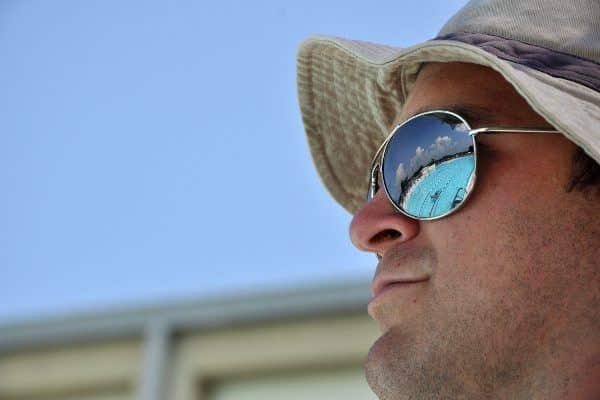Summer is a time for fun and outdoor activities. After being cooped up all winter, it is a treat to get outside and play around. You probably spend a lot of time choosing a sunscreen that is the most protective for you and your loved ones. But do you put the same kind of thought and care into choosing your sunglasses? Jackson Davenport Vision Center helps you make the smartest choices to keep your eyes safe and healthy this summer. In this article, you will read about the benefits and dangers of the sun’s rays to your eye health and the steps to ensure you have the most safety in the sunshine.
What are the Benefits of Sunshine to My Eyes?
There may be a correlation between the amount of sunshine the eye receives and myopia. Those with myopia tend to be nearsighted due to the presence of longer eyeballs, the length of which changes the angle at which light enters the eye. According to the New York Times, myopia develops because of genetics and environmental factors, beginning early childhood and worsening in early adulthood. The reason may be that more youth are spending a lot of quality time with their screens rather than outdoors. The rise in those with myopia seems to parallel the emergence of technology in our daily lives. Therefore, scientists believe that proper and safe exposure to sunlight, beginning at an early age, can benefit your eye health and assist in the proper development of the eyeball. So, the sun is good for eye health! That’s great news. And with great news comes great responsibility: to keep the sun’s exposure to your eyes beneficial, it is important to exercise safety when exposed to the sun’s rays.
How Do the Sun’s Rays Hurt My Eyes?
You probably know the sun’s ultraviolet rays can cause damage to the skin, as overexposure can ultimately lead to skin cancer. It is less common knowledge that these same rays can also damage the eyes.
According to the Skin Cancer Foundation, two types of ultraviolet rays reach the Earth through the ozone layer: UVA (long-wave) and UVB (shortwave).
- UVA rays make up 95 percent of the radiation that reaches the earth’s surface, and they are present throughout all daylight hours during every part of the year and can penetrate clouds and glass.
- UVB causes damage on a more superficial level than UVA and is seasonal to April-October, at peak daylight hours, typically between 10 am and 4 pm. UVB is especially present at high altitudes where the ozone layer is thinner and cannot filter the light as effectively as at sea level.
Both types of rays can penetrate the unprotected eye. More specifically, UVA can hurt the central vision–the back of your eye called the macula. UVB is absorbed in the front part of the eye–the cornea and the lens–but may be even more harmful to your eyes than UVA rays. But what exactly comes from the exposure to and absorption of these rays in your eyes?
What Conditions Do the Sun’s Rays Cause?
The conditions resulting from the harmful effects of the sun include:
- Macular degeneration: Damage to the retina that destroys the central vision. It is the leading cause of blindness in the older generation of Americans.
- Cataract: The clouding of the eye’s natural lens (focusing on the light we see) results in blurry vision.
- Pterygium: A tissue growth that develops on the white of the eye and can block vision, manifesting in astigmatism.
- Corneal Sunburn: Temporary vision loss from high-intensity short-term exposure to UVB rays.
These conditions can be painful and irreversible. There is hope, however, of protecting yourself and your loved ones from overexposure.
The Real Meaning of Sunglasses
While, over time, sunglasses have become more of a fashion statement than a protective cover, it is important to remember their intended purpose: to protect the eye from the sun’s harmful UV rays.
In 2013, the American Optometric Association (AOA) found that only 40 percent of consumers wore sunglasses to protect their eyes from sun damage. Only 28 percent said, “UV protection is the most important factor when purchasing sunglasses.” Another study conducted by the AOA stated that “only 21 percent of parents purchased their child’s first pair of eyeglasses before the infant’s first birthday.” Eye health is important from the first exposure to the sun’s rays. Young to not-so-young, everyone should have a good, protective pair of sunglasses that keep their eyes out of harm’s way.
What Can I Do to Protect My Eyes?
- Buy a good pair of sunglasses. It is recommended by the AOA and the National Eye Institute that they should block at least 95 percent of UVA radiation and 99 percent of UVB radiation. They should also block 75-90 percent of visible light and be free of distortions, so protection is even. The frames should be close to your eyes and fit the shape of your head, protecting you from 360 degrees of rays.
- If you wear contact lenses, find ones that boast UV protection.
- Apply UV protective sunscreen around the eyes and face when you are out of doors.
- Wear a hat that blocks direct sunlight from your face. In other words, bring back the big straw hat fashion trend!
- Avoid midday sunlight. Enjoy an early morning book or late afternoon barbecue outside.
- Get UV-protective prescription lenses. Eyeglasses can be made with UV protection and tints to fit your lifestyle. See your local Summerville, SC optometrist to find the right fit.
It is important to maintain good eye health this summer. You can feel comfortable doing so in a pair of attractive and effective sunglasses. By going to Jackson Davenport Vision Center, you can monitor your eye health, maintain quality vision by scheduling your comprehensive eye exam, and be fitted for your new stylish and protective sunglasses. With the proper knowledge of exposure to UV rays and help from your optometrist, you can look good while having the playful summer you crave with the protection you need!

